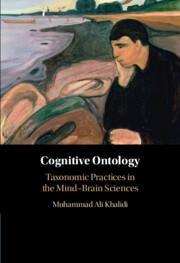Book contents
- Cognitive Ontology
- Cognitive Ontology
- Copyright page
- Dedication
- Contents
- Figures
- Contributors
- Preface
- Chapter 1 Cognitive Kinds
- Chapter 2 Concepts
- Chapter 3 Innateness
- Chapter 4 Domain Specificity
- Chapter 5 Episodic Memory
- Chapter 6 Language-Thought Processes
- Chapter 7 Cognitive Heuristics and Biases
- Chapter 8 Body Dysmorphic Disorder
- Chapter 9 Epilogue
- References
- Index
Chapter 5 - Episodic Memory
Published online by Cambridge University Press: 15 January 2023
- Cognitive Ontology
- Cognitive Ontology
- Copyright page
- Dedication
- Contents
- Figures
- Contributors
- Preface
- Chapter 1 Cognitive Kinds
- Chapter 2 Concepts
- Chapter 3 Innateness
- Chapter 4 Domain Specificity
- Chapter 5 Episodic Memory
- Chapter 6 Language-Thought Processes
- Chapter 7 Cognitive Heuristics and Biases
- Chapter 8 Body Dysmorphic Disorder
- Chapter 9 Epilogue
- References
- Index
Summary
This chapter discusses the kind, episodic memory, which has recently garnered a great deal of attention from philosophers. In light of current empirical work, it has become increasingly challenging to accept an influential and intuitively plausible philosophical account of memory, namely the “causal theory of memory.” It is unlikely that each episodic memory can be associated with a trace or “engram” that can be shown to be linked by an uninterrupted causal chain to an episode in the thinker’s past. Some philosophers and psychologists have responded by effectively abandoning the category of episodic memory and assimilating memory to imagination or hypothetical thinking. But I argue that there is still room for a distinct cognitive kind, episodic memory, a cognitive capacity whose function it is to generate representational states that are connected to past episodes in the experience of the thinker, which bear traces of these episodes that are individuated not at the neural level but at the “computational level.”
Information
- Type
- Chapter
- Information
- Cognitive OntologyTaxonomic Practices in the Mind-Brain Sciences, pp. 123 - 157Publisher: Cambridge University PressPrint publication year: 2023
Accessibility standard: Unknown
Why this information is here
This section outlines the accessibility features of this content - including support for screen readers, full keyboard navigation and high-contrast display options. This may not be relevant for you.Accessibility Information
- 1
- Cited by
